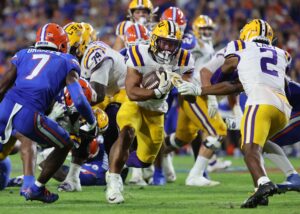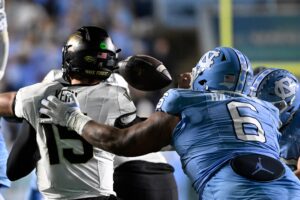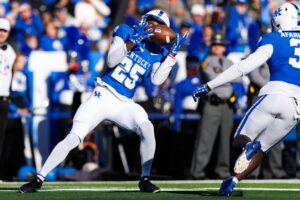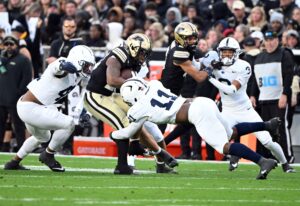West Virginia Mountaineers: Season in Review
The Mountaineers’ 2019 football season has come to a close, barring any unexpected bowl invitation. As a result, it is time to peek under the hood and see what went right and wrong in Head Coach Neal Brown’s first season. As he told and Shane Lyons told us early this season, the Mountaineers looked to build a blue-collar team. They both preached patience and asked fans and players to “trust the climb.” As we’ve discussed in several of our weekly recaps, that climb was never really about season one. Instead, the climb focused on the future of the program, which, overall, seems bright. With that said, we’ll conduct our Mountaineers: season in review.
Reviewing the Offense
Replacements and Change
We begin our Mountaineers’ season in review by looking at the offense. 2019 was always going to be rocky for West Virginia. The Mountaineers replaced an early Heisman contender in Will Grier with a quartet of signal-callers who collectively played about 100 snaps of Power 5 football. They lost about 85% of their wide receiver and tight end production from 2018. Finally, they returned only 40% of their offensive line’s snap count from the prior season. Without any changes to the staff, the season outlook seemed bleak.
Add to that the change in offensive staff and general philosophy, and the Mountaineers seemed destined for a major offensive regression. Brown, of course, grew up with the air raid concepts the previous staff employed. Further, he also took stock of the Big XII defenses and told fans at Big XII media days that he hoped to establish a clock-controlling power-run game to complement those air raid concepts.
Offensive Line and Running Game
With a change in philosophy came a major shift in the offensive line’s task. Instead of scheming around perceived recruiting deficits on the line through zone blocking and creative run plays, Brown and Offensive Line Coach Matt Moore asked the unit to play more physically and to attack opposing defenses straight-on. It might not seem like much, at first blush, but the season’s results should show otherwise.
After all, the returning “stars” on the offensive came in Colton McKivitz and Josh Sills. Both struggled at times during the season (though Sills was injured early) to open up running lanes. Plus, outside of McKivitz and Kelby Wickline, the Mountaineers largely employed Chase Behrndt (under 350 snaps in 2018), Mike Brown (under 25 snaps in 2018), James Gmiter, and Briason Mays. The final two names represent redshirt freshmen. Neither of whom registered a single snap in their college careers before this season.
In the Spring Game, in fact, both units of the West Virginia offense consistently struggled to run the ball. Things did not improve drastically heading into the first week of the season. As a result, most observers predicted that the Mountaineer offense would live and die with the performance of its offensive line. That line struggled mightily throughout the season. Its pass protection offered more hope than its run blocking. Neither aspect of the unit’s performance inspired confidence.
Therefore, Brown’s hopes to establish a power running game fell flat. Further, the running backs, each of whom has shown significant streaks of brilliance through their careers, had no room to work. West Virginia tallied under three yards per carry over the course of the season.
Passing Game
In a recent interview, junior wide-out T.J. Simmons expressed excitement about the future of the Mountaineers’ aerial attack. He also defended quarterback Austin Kendall. Kendall, he said, suffered because he was getting “banged up almost every play.” Kendall did suffer a hand injury early in the season that he never seemed to shake.
Understandably frustrated fans and bloggers loudly and vehemently “demanded” that Brown replace Kendall with Trey Lowe or Jarret Doege. Brown defended his starter, noting that the issues with the offense could not be solved merely with a quarterback change. He was not necessarily wrong. Pass protection breakdowns, dropped passes, and an ineffective running game plagued Doege when Brown called on him for the final three-and-a-half games of the season.
Doege flashed more accuracy, a better deep ball, and far more evasiveness than Kendall did. Ultimately, these traits helped Doege carry the offense to wins over a ranked Kansas State and a TCU team fighting for bowl eligibility. That said, the offense didn’t light up the scoreboard in either game. The Mountaineers scored 44 points–total–in both of those two wins.
That isn’t to say that Doege isn’t the Mountaineers’ answer for the next two seasons. He most likely starts in 2020 and 2021. He certainly played well enough to earn the presumption that he is West Virginia’s 2020 starter. Instead, it demonstrates that Brown was right. The Mountaineers’ offensive woes fall more squarely on the offensive line’s and receiving corps’ inexperience. Precisely what many predicted before the season.
Admittedly, we felt that Kendall offered the Mountaineers the best chance at success in 2019. As a result of pre-season questions surrounding Kendall, we called him one of our biggest offensive surprises for 2019. We admit we were wrong. Doege really looked the part. His game-winning passes to Bryce Wheaton and Isaiah Esdale punctuated that point.
We were right in our predicting George Campbell to be the Mountaineers’ single-biggest offensive surprise in 2019. Campbell accounted for seven touchdowns on just 19 receptions. That’s an amazing 37% of his catches going for six while averaging 25 yards per catch. While Campbell’s sample size is smaller, touchdown-machine David Sills, by comparison, scored on just 25% of his receptions over his career. Finally, consummate deep threat Shelton Gibson averaged 23 yards per reception over his career.
Reviewing the Defense
The Defensive Line
As we wrote in our article predicting the top five defensive surprises for the Mountaineers in 2019, the Mountaineers switched from a 3-3-5 to a 4-2-5 base defense this season. After injuries decimated the Mountaineers’ depth at the bandit position. They relied on four down-linemen more than anticipated. Based on the switch, we predicted a huge surge in production from the defensive line. In total, the defensive line accounted for 147 tackles, 39.5 tackles for loss, 22.5 sacks, and seven pass deflections. That compares favorably to the unit’s totals for 2018. It netted 122 tackles, 23 tackles for loss, seven-and-a-half sacks, and two pass deflections in 2018.
We also predicted Reuben Jones and Darius Stills to fill two of those five spots. Neither failed to live up to the promise. Jones added a veteran presence to the defense both on and off the field. In addition, the older Stills brother cemented his place in the halls of Mountaineer history. The two combined racked up 71 tackles, 16.5 tackles for loss, nine sacks, and two pass deflections.
The Unit as a Whole
In total, the defense tallied 79 tackles for loss and 33 sacks. Perhaps more importantly, 22 different West Virginia defensive players contributed at least part of a tackle for loss. Also, 12 different Mountaineer players contributed at least a sack. No doubt that Defensive Coordinator Vic Koenning dialed up pressure more effectively than in years past. In 2018, by comparison, the Mountaineers netted only 27 sacks (over one more game).
It took West Virginia a while, however, to overcome the depth issues they faced after Dana Holgorsen’s departure and adjust to the things Koenning was asking them to do. In their first six games against Power 5 opponents, the defense surrendered an average of 37 points per game. Those opponents collectively averaged 31 points per game. So the Mountaineers actually fared worse than their opponents’ average scoring output by six points. But over the final five games, something changed. The Mountaineers hit their stride. As a result, they held opponents otherwise averaging 31 points per game to just 22.
Safe to say, then, that the Mountaineers’ defense improved dramatically over the course of the season. Thus, while the final numbers may not look great, the defense laid the first bricks of a solid foundation.
Previewing the Future
To end our Mountaineers’ season in review, we want to hit on a few high notes for the future of the program. Brown, after all, assured fans that he and his staff are building a solid program here. There is little reason to doubt him.
Looking beyond the win-loss record (because West Virginia’s five wins only tell a small part of this season’s story), clues to future success appear. As an initial matter, we must note that Brown returned a very low percentage of West Virginia’s 2018 contributors. As we wrote above, the Mountaineers lost their starting quarterback, 85% of their wide-out and tight-end production, and 60% of their offensive line snaps. On defense, the Mountaineers lost 40% of their top 20 defensive producers from 2018 and about 50% of the production. In 2018, of course, West Virginia remained in the hunt for the Big XII Championship game up until its final game, a gut-wrenchingly close loss to Oklahoma at home. They finished 8-4 with an offense and defense that returned several all-time greats.
Enter Neal Brown. Facing questions over whether he was the right hire, having to retain a recruiting class that he inherited from the prior staff, and replacing a half dozen or more historically-great Mountaineers, Brown held a mixed bag. Youth and inexperience littered his depth chart, but the talent was there and desire was flamed. Brown took that youth and inexperience, inserted some critical graduate transfers, and won five games. He was just two scores away from winning seven.
Next year, the Mountaineers should return 65% of its top 20 defensive players and over 70% of the production. He will also add VanDarius Cowan and heavily-recruited Dreshun Miller, both of whom played sparsely due to injury, to the fold in 2020. On offense, West Virginia will return at least 80% of its wide receiver and tight end production. It will return 100% if Campbell seeks (as many predict) and is granted a 6th year of eligibility. The Mountaineers will return their starting quarterback. They will also return over half of their running back production and 60% of its offensive line’s snap count.
Even if the Mountaineers see more attrition this offseason, and there are many credible rumors that they will, that attrition will impact second- and third-string players at worst. As we will discuss in our next article, Brown and his staff have and will continue to address the team’s needs through recruiting. He is already building a solid class to add to the experience he returns next year. The next step of the climb begins immediately. The team could ascend rapidly.






